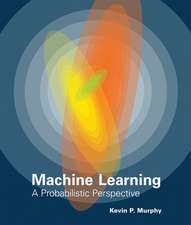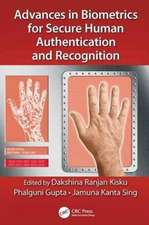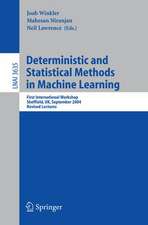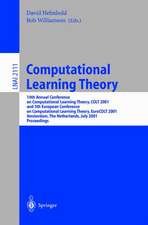From Curve Fitting to Machine Learning: An Illustrative Guide to Scientific Data Analysis and Computational Intelligence: Intelligent Systems Reference Library, cartea 18
Autor Achim Zielesnyen Limba Engleză Hardback – 28 iul 2011
But it was the advent of digital computers that allowed the execution of highly non-linear and increasingly complex data analysis procedures - methods that were completely unfeasible before. Non-linear curve fitting, clustering and machine learning belong to these modern techniques which are a further step towards computational intelligence.
The goal of this book is to provide an interactive and illustrative guide to these topics. It concentrates on the road from two dimensional curve fitting to multidimensional clustering and machine learning with neural networks or support vector machines. Along the way topics like mathematical optimization or evolutionary algorithms are touched. All concepts and ideas are outlined in a clear cut manner with graphically depicted plausibility arguments and a little elementary mathematics. The major topics are extensively outlined with
exploratory examples and applications. The primary goal is to be as illustrative as possible without hiding problems and pitfalls but to address them. The character of an illustrative cookbook is complemented with specific sections that address more fundamental questions like the relation between machine learning and human intelligence. These sections may be skipped without affecting
the main road but they will open up possibly interesting insights beyond the mere data massage.
All topics are completely demonstrated with the aid of the commercial computing platform Mathematica and the Computational Intelligence Packages (CIP), a high-level function library developed with Mathematica's programming language on top of Mathematica's algorithms. CIP is open-source so the detailed code of every method is freely accessible. All examples and applications shown throughout the book may be used and customized by the reader without any
restrictions.
The target readerships are students of(computer) science and engineering as well as scientific practitioners in industry and academia who deserve an illustrative introduction to these topics. Readers with programming skills may easily port and customize the provided code.
| Toate formatele și edițiile | Preț | Express |
|---|---|---|
| Paperback (1) | 1624.04 lei 6-8 săpt. | |
| Springer International Publishing – 22 apr 2018 | 1624.04 lei 6-8 săpt. | |
| Hardback (2) | 661.14 lei 6-8 săpt. | |
| Springer Berlin, Heidelberg – 28 iul 2011 | 661.14 lei 6-8 săpt. | |
| Springer International Publishing – 22 apr 2016 | 1630.47 lei 6-8 săpt. |
Din seria Intelligent Systems Reference Library
- 20%
 Preț: 1050.57 lei
Preț: 1050.57 lei - 20%
 Preț: 1157.60 lei
Preț: 1157.60 lei - 20%
 Preț: 648.44 lei
Preț: 648.44 lei - 20%
 Preț: 650.08 lei
Preț: 650.08 lei - 20%
 Preț: 1005.64 lei
Preț: 1005.64 lei - 5%
 Preț: 968.88 lei
Preț: 968.88 lei - 20%
 Preț: 1052.67 lei
Preț: 1052.67 lei - 20%
 Preț: 1171.46 lei
Preț: 1171.46 lei - 20%
 Preț: 1164.84 lei
Preț: 1164.84 lei - 20%
 Preț: 815.83 lei
Preț: 815.83 lei - 20%
 Preț: 989.96 lei
Preț: 989.96 lei - 20%
 Preț: 1063.41 lei
Preț: 1063.41 lei - 20%
 Preț: 925.45 lei
Preț: 925.45 lei - 20%
 Preț: 504.37 lei
Preț: 504.37 lei - 18%
 Preț: 1113.26 lei
Preț: 1113.26 lei - 20%
 Preț: 1920.04 lei
Preț: 1920.04 lei - 20%
 Preț: 990.62 lei
Preț: 990.62 lei - 20%
 Preț: 651.57 lei
Preț: 651.57 lei - 20%
 Preț: 645.97 lei
Preț: 645.97 lei - 20%
 Preț: 660.16 lei
Preț: 660.16 lei - 20%
 Preț: 647.13 lei
Preț: 647.13 lei - 20%
 Preț: 654.05 lei
Preț: 654.05 lei - 20%
 Preț: 649.93 lei
Preț: 649.93 lei - 20%
 Preț: 648.11 lei
Preț: 648.11 lei - 20%
 Preț: 657.99 lei
Preț: 657.99 lei - 20%
 Preț: 656.84 lei
Preț: 656.84 lei - 20%
 Preț: 1624.04 lei
Preț: 1624.04 lei - 20%
 Preț: 642.98 lei
Preț: 642.98 lei - 20%
 Preț: 649.60 lei
Preț: 649.60 lei - 20%
 Preț: 651.23 lei
Preț: 651.23 lei - 20%
 Preț: 653.06 lei
Preț: 653.06 lei - 20%
 Preț: 1002.99 lei
Preț: 1002.99 lei - 20%
 Preț: 645.14 lei
Preț: 645.14 lei - 20%
 Preț: 658.33 lei
Preț: 658.33 lei - 20%
 Preț: 644.98 lei
Preț: 644.98 lei - 20%
 Preț: 646.62 lei
Preț: 646.62 lei
Preț: 661.14 lei
Preț vechi: 826.42 lei
-20% Nou
Puncte Express: 992
Preț estimativ în valută:
126.51€ • 132.08$ • 104.70£
126.51€ • 132.08$ • 104.70£
Carte tipărită la comandă
Livrare economică 04-18 aprilie
Preluare comenzi: 021 569.72.76
Specificații
ISBN-13: 9783642212796
ISBN-10: 3642212794
Pagini: 484
Ilustrații: XV, 465 p.
Dimensiuni: 155 x 235 x 32 mm
Greutate: 0.85 kg
Ediția:2011
Editura: Springer Berlin, Heidelberg
Colecția Springer
Seria Intelligent Systems Reference Library
Locul publicării:Berlin, Heidelberg, Germany
ISBN-10: 3642212794
Pagini: 484
Ilustrații: XV, 465 p.
Dimensiuni: 155 x 235 x 32 mm
Greutate: 0.85 kg
Ediția:2011
Editura: Springer Berlin, Heidelberg
Colecția Springer
Seria Intelligent Systems Reference Library
Locul publicării:Berlin, Heidelberg, Germany
Public țintă
ResearchCuprins
Introduction.- Curve Fitting.- Clustering.- Machine Learning.- Discussion.- CIP - Computational Intelligence Packages.
Recenzii
From the reviews:
“‘From curve fitting to machine learning’ is … a useful book. … It contains the basic formulas of curve fitting and related subjects and throws in, what is missing in so many books, the code to reproduce the results. … All in all this is an interesting and useful book both for novice as well as expert readers. For the novice it is a good introductory book and the expert will appreciate the many examples and working code.” (Leslie P. Piegl, Zentralblatt MATH, Vol. 1236, 2012)
“‘From curve fitting to machine learning’ is … a useful book. … It contains the basic formulas of curve fitting and related subjects and throws in, what is missing in so many books, the code to reproduce the results. … All in all this is an interesting and useful book both for novice as well as expert readers. For the novice it is a good introductory book and the expert will appreciate the many examples and working code.” (Leslie P. Piegl, Zentralblatt MATH, Vol. 1236, 2012)
Textul de pe ultima copertă
The analysis of experimental data is at heart of science from its beginnings.
But it was the advent of digital computers that allowed the execution of highly non-linear and increasingly complex data analysis procedures - methods that were completely unfeasible before. Non-linear curve fitting, clustering and machine learning belong to these modern techniques which are a further step towards computational intelligence.
The goal of this book is to provide an interactive and illustrative guide to these topics. It concentrates on the road from two dimensional curve fitting to multidimensional clustering and machine learning with neural networks or support vector machines. Along the way topics like mathematical optimization or evolutionary algorithms are touched. All concepts and ideas are outlined in a clear cut manner with graphically depicted plausibility arguments and a little elementary mathematics. The major topics are extensively outlined with
exploratory examples and applications. The primary goal is to be as illustrative as possible without hiding problems and pitfalls but to address them. The character of an illustrative cookbook is complemented with specific sections that address more fundamental questions like the relation between machine learning and human intelligence
All topics are completely demonstrated with the aid of the commercial computing platform Mathematica and the Computational Intelligence Packages (CIP), a high-level function library developed with Mathematica's programming language on top of Mathematica's algorithms. CIP is open-source so the detailed code of every method is freely accessible. All examples and applications shown throughout the book may be used and customized by the reader without any restrictions.
But it was the advent of digital computers that allowed the execution of highly non-linear and increasingly complex data analysis procedures - methods that were completely unfeasible before. Non-linear curve fitting, clustering and machine learning belong to these modern techniques which are a further step towards computational intelligence.
The goal of this book is to provide an interactive and illustrative guide to these topics. It concentrates on the road from two dimensional curve fitting to multidimensional clustering and machine learning with neural networks or support vector machines. Along the way topics like mathematical optimization or evolutionary algorithms are touched. All concepts and ideas are outlined in a clear cut manner with graphically depicted plausibility arguments and a little elementary mathematics. The major topics are extensively outlined with
exploratory examples and applications. The primary goal is to be as illustrative as possible without hiding problems and pitfalls but to address them. The character of an illustrative cookbook is complemented with specific sections that address more fundamental questions like the relation between machine learning and human intelligence
All topics are completely demonstrated with the aid of the commercial computing platform Mathematica and the Computational Intelligence Packages (CIP), a high-level function library developed with Mathematica's programming language on top of Mathematica's algorithms. CIP is open-source so the detailed code of every method is freely accessible. All examples and applications shown throughout the book may be used and customized by the reader without any restrictions.
Caracteristici
An interactive and illustrative guide to scientific data analysis and computational intelligence Introduction to curve fitting, clustering and machine learning along with topics like mathematical optimization or evolutionary algorithms All concepts and ideas are outlined in a clear cut manner with graphically depicted plausibility arguments and a little elementary mathematics
















